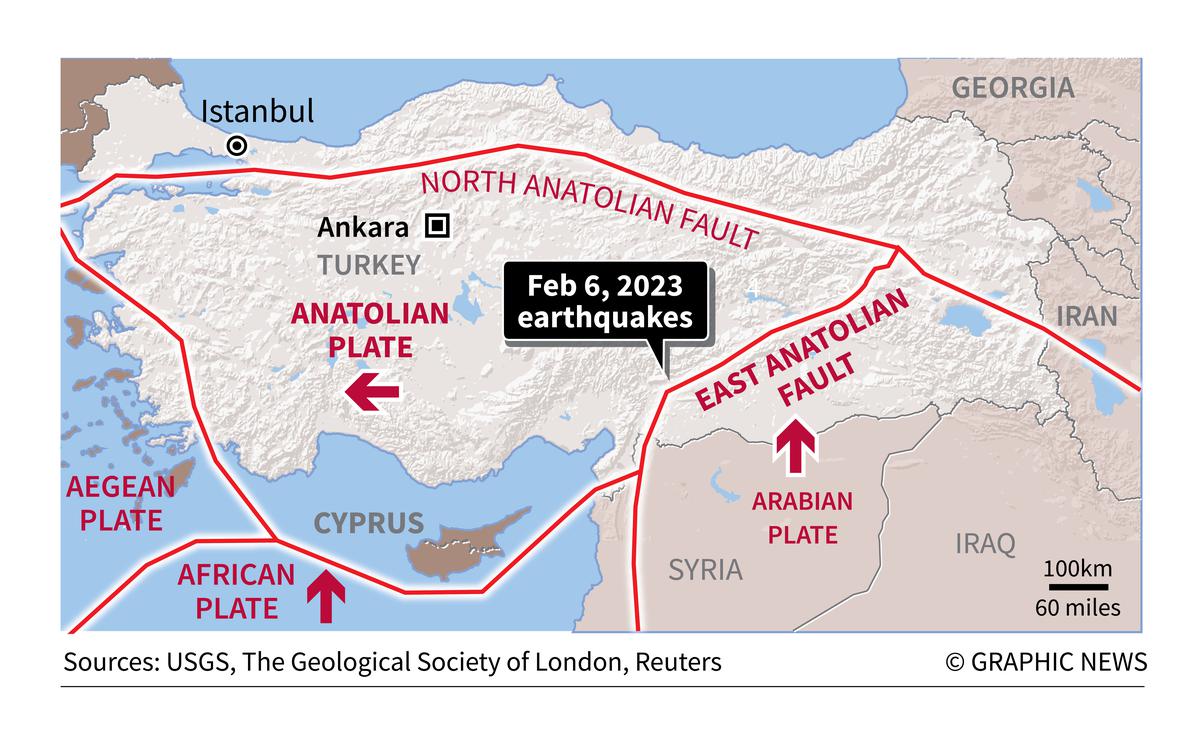Complete devastation: Searching for survivors in a collapsed building after the earthquake in Kahramanmaras, Turkey, February 11, 2023. , Photo Credit: Reuters
the story So Far: Two major earthquakes, one of magnitude 7.8 and then one of magnitude 7.5, hit southeastern Turkey, killing at least 17,000 people and counting, causing significant damage in Turkey as well as Syria. About 200 aftershocks accompanied the magnitude 6 earthquake in the region three days after the first tremor.
What causes earthquakes?
Earth’s crust is made up of about 15 huge fragmented chunky slabs called tectonic plates which are in constant motion. The land on which buildings are built rests on these plates. The plates constantly collide, push and collide with each other and the meeting points of these plates are made up of a series of ‘faults’.
Energy suppressed by nestling plates along faultlines is often released when the imbalance in pressure causes the rocks on either side of the fault to readjust. One set of rocks rising up relative to another is a ‘normal’ fault, sliding down relative to another is a ‘reverse’ fault. When they grate, or move past each other, it is a ‘strike-slip’. The released energy travels in the form of waves which cause the ground to shake.
What kind of earthquake happened in Turkey and Syria?
Turkey and Syria lie at the confluence of three plates – the Arabian Plate, the Anatolian Plate and the Eurasian Plate, making the region an extremely seismically active region. The Arabian Plate is moving north in Europe, pushing the Anatolian Plate (on which Turkey sits) out to the west. The bulk of Turkey sits between two major faults on the Anatolian Plate: the North Anatolian Fault and the East Anatolian Fault.

Geologists say that the earthquake was caused by ‘strike-slip’ which is typical of earthquakes in this region.
Why were these earthquakes so devastating and deadly?
As this region hosts many fault systems, many earthquakes are being recorded in this region. Only those that result in the release of energy above a certain threshold are captured by seismic devices. At magnitude 7.8, the February 6 event is much larger than those the region has experienced before. The fault system runs along about 190 km which is why the effects of the earthquake were so far-reaching.
The second earthquake, of magnitude 7.5, occurred further north on a separate but adjacent fault system called the Sergu Fault. The magnitude of these earthquakes suggests that there will be many aftershocks that can be recorded over a wide radius and tremors have been reported from as far away as Cairo (950 km) and Istanbul (815 km).
Are there similarities with the earthquake in India? Can energy be built up over years from latent pressure?
The Indian Plate, which collided with the Eurasian Plate and tilted upwards, formed the Himalayas. Pune-based geologist Suvrat Kher says the most common type of earthquake in the Himalayan region is caused by reverse faults caused by compressive forces between two plates. “However, whether it is a strike-slip or a thrust, the waves generated can be just as powerful.” Scientists have long warned of large-scale earthquakes here in the Garhwal-Kumaon range because of what is known about earthquake patterns in the region.
Based on the amount of ‘slip’ (or motion) observed in an earthquake, and by measuring the amount of ‘strain’ that accumulates each year, scientists can deduce the latent pressure that is building up along a fault . “We don’t have very precise records that date earthquakes of magnitude 7+ over a thousand years ago. Records from the last 300 or so years show that the ones that have occurred haven’t released all the pent-up energy and that’s why We think a major one – perhaps even an 8 magnitude one – is overdue. However, predicting the day when it will happen is beyond our grasp,” VK Gehlaut, seismologist and professor at the National Geophysical Research Institute (NGRI), Hyderabad he said.
He said that in the Turkey-Syria earthquakes, energy was released from about 300 years of accumulated stress.
How much is the intensity of earthquakes related to the damage caused by them?
It is only roughly true that the intensity of an earthquake corresponds to the death and devastation. Chile, a country with a long history of devastating earthquakes (more than 9), is considered a model for earthquake preparedness.
Despite experiencing earthquakes of greater magnitude 8 in 2014 and 2015, casualties have been extremely low due to years of strict enforcement of building codes. It is also known for its experience in earthquake resistant structures, despite being a much poorer country than Japan.
The tsunami and radiation leak at the nuclear power plant in the country’s Fukushima Prefecture in 2011 caused by a 9-magnitude earthquake did not damage the stability of the structure, Mr Gehlaut said. “As the energy released increases rapidly by one step of the scale (moment magnitude), the cost of earthquake-proofing also increases rapidly. On the other hand, if structures are built on fault lines, any engineering Money can’t save them.”
The lack of enforcement of building codes in Turkey and the timing of the earthquake in the early hours of the morning are believed to be major factors in the death and devastation. “It is a bit like India where we have a lot of regulations (on building codes) but limited enforcement. For example the 1993 Latur earthquake was a little over magnitude 6 but caused huge damage because the building codes were not enforced there are,” Mr. Kher said.